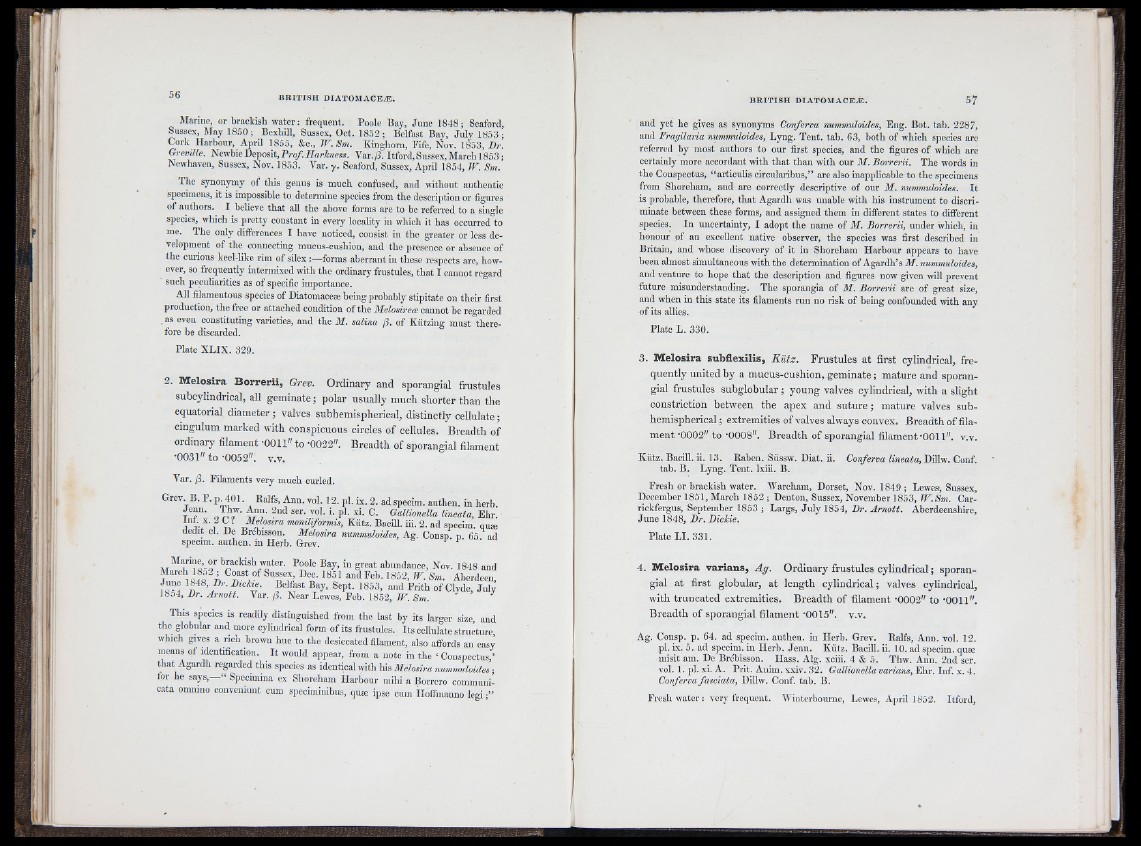
Marine, or brackish water: frequent. Poole Bay, June 1848; Seaford,
Sussex, May 1850; Bexhill, Sussex, Oct. 1852; Belfast Bay, July 1853;
Cork Harbour, April 1855, &c., IF. Sm. Kinghorn, Fife, Nov. 1853, D/.
GreviUe. NevjhieDeposit,Prof.Harkness. Var./3. Itford,Sussex,March 1853;
Newhaven, Sussex, Nov. 1853. Var. y. Seaford, Sussex, April 1854, TF. Sm.
The synonymy of this geiras is much confused, aud without authentic
specimens, it is impossible to determine species from the description or figures
of authors. I believe that all the above forms are to be referred to a single
species, which is pretty constant in every locality iu wliich it has occurred to
me. The only differences I have noticed, consist in the greater or less development
of the connecting mucus-cushion, and the presence or absence of
the curious keel-like rim of silex :—forms aberrant in these respects are, however,
so frequently intermixed witli the ordinary frustules, that I cannot regard
■ such peculiarities as of specific importance.
All filamentous species of Diatomaceæ being probably stipitate on their first
production, the free or attached condition of the Melosireæ cannot be regarded
, as even constituting varieties, aud the M. salina ft. of Kützing must therefore
be discarded.
Plate XLIX. 329.
2. Melosira Borrerii, Grev. Ordinary and sporangial frustules
subcylindrical, all geminate ; polar usually much shorter than the
equatorial diameter ; valves subhemispherical, distinctly cellulate ;
cingulum marked with conspicuous circles of cellules. Breadth of
ordinary filament -OOll" to -0022". Breadth of sporangial filament
•0031" to -0052". v.v.
Var. ft. Filaments very much curled.
Grev B .P .p 401. Ealfs, Ann. vol. 12.pl.ix. 2. ad specim. authen. in herb.
T P'- ’"■• Gdllionella lineata, Ehr.
Int X . i 0 ? Melosira moniliformis, Kùtz. Bacill. iii. 2. ad specim. quæ
dedit cl. De Brebisson. Melosira nummuloides, Ag. Consp. p. 65 ad
specim. authen. in Herb. Grev.
Marine,_or brackish water. Poole Bay, in great abundance, Nov. 1848 and
i i raas n n z. dY; “ "n?- W. Sm. Aberdeen,
ra w lSi)4, DI r . AAr ?ioFtt.F V4 a' r. Nea‘ r Lewes, Feb. 1852, ,S'wz. Clyde, July
This species is readily distinguished from the last by its larger size, and
the globular and more cylindrical form of its frustules. Its cellulate structure,
which gives a rich brown hue to the desiccated filament, also affords an easy
means of identification. It would appear, from a note in the ‘ Conspectus ’
that Agardh regarded this species as identical with hh Melosira nummuloUe's-,
tor he says, “ Specimina ex Shoreham Harbour mihi a Borrero communi-
cata omnino couveniunt cum specimiiiibus, quæ ipse cum Iloffinaimo Icgi ;”
and yet he gives as synonyms Conferva nummuloides, Eng. Bot. tab. 2287,
and Fragilaria nummuloides, Lyng. Tent. tab. 63, both of which species are
referred by most authors to our first species, and the figures of which are
certainly more accordant with that than with our M. Borrerii. The words in
the Conspectus, “ articulis circularibus,” are also inapplicable to the specimens
from Shoreham, and are correctly descriptive of our M. nummuloides. It
is probable, therefore, that Agardh was unable with his instrument to discriminate
between these forms, and assigned them in different states to different
species. In uncertainty, I adopt the name of M. Borrerii, under which, in
honour of an excellent native observer, the species was first described in
Britain, and whose discovery of it in Shoreham Harbour appears to have
been almost simultaneous with the determination of Agardh’s M. nummuloides,
and venture to hope that the description and figures now given will prevent
future misunderstanding. The sporangia of M. Borrerii are of great size,
and when in this state its filaments run no risk of being confounded with any
of its allies.
Plate L. 330.
3. Melosira subflexilis, Kiitz. Frustules at first cylindrical, frequently
united by a mucus-cushion, geminate ; mature and sporangial
frustules subglobular ; young valves cylindrical, with a slight
constriction between the apex and suture ; mature valves sub-
hemispherical ; extremities of valves always convex. Breadth of filament
•0002" to •0008". Breadth of sporangial filament-0011". v.v.
Kütz. Bacill. ii. 13. Raben. Süssw. Diat. ii. Conferva lineata, Dillw. Conf.
tab. B. Lyng. Tent. Ixiii. B.
Fresh or brackish water. 'IVareham, Dorset, Nov. 1849 ; Lewes-, Sussex,
December 1851, March 1852 ; Denton, Sussex, November 1853, W.Sm. Carrickfergus,
September 1853 ; Largs, July 1854, Dr. Arnott. Aberdeenshire,
June 1848, Dr. Dickie.
Plate LI. 331.
4. Melosira varians, Ag. Ordinary frustules cylindrical; sporangial
at first globular, at length cylindrical; valves cylindrical,
with truncated extremities. Breadth of filament -0002" to •OOll".
Breadth of sporangial filament •0015". v.v.
Ag. Consp. p. 64. ad specim. authen. in Herb. Grev. Ralfs, Ann. vol. 12.
pl. ix. 5. ad specim. in Herb. Jenn. Kûtz. Bacill. ii. 10. ad specim. quæ
misit am. De Brebisson. Hass. Alg. xciii. 4 & 5. Thw. Ann. 2nd ser.
vol. 1. pl. xi. A. Prit. Anim. xxiv. 32. GalUonella varians, Ehr. Inf. x. 4 .
Conferva fasciata, Dillw. Conf. tab. B.
Fresh water : very frequent. Wiiiterbourne, Lewes, April 1852. Itford,